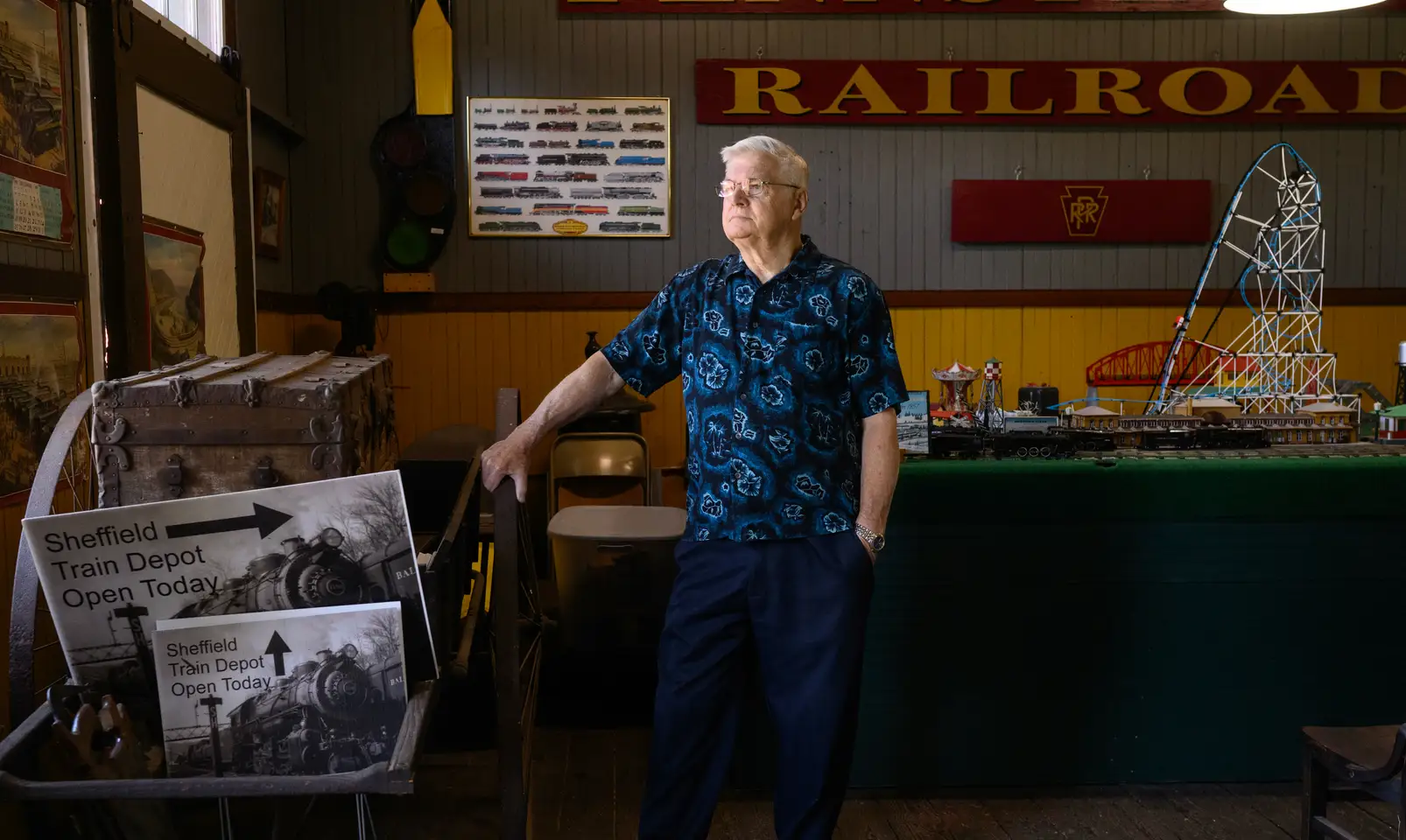Rural America faces a slow collapse as birth rates fall behind death rates in 81% of counties

Lee Goldthwaite might have the most secure job in this remote stretch of northwestern Pennsylvania. As caretaker of Sheffield Cemetery, he’s busier than ever, overseeing crews removing trees to accommodate more burial plots. Deaths now far outnumber births in this part of the country and other wide rural regions. With each funeral, Goldthwaite wonders how a town that once attracted many young families can endure.
“We already lost our bank,” Goldthwaite said, pausing while trimming the grass between graves. “We lost our liquor store, and we may be about to lose our high school.” A growing anxiety about what lies ahead is gripping rural Pennsylvania as population decline speeds up. The drop has made the state a key player in the larger national debate about the sustainability of small towns—long considered a vital part of America’s identity.
Data from the U.S. Census Bureau show that rural populations began falling around a decade ago. Between 2019 and 2023, 81 percent of rural counties recorded more deaths than births, according to a University of New Hampshire demographer. Experts attribute the trend to aging baby boomers, fewer children being born, and younger generations moving away for employment.
Although a recent Agriculture Department report noted a slight 0.25 percent rural population increase from 2020 to 2022, largely due to pandemic-era urban flight, demographers are still unsure whether that bump will hold—and where it might lead. Pennsylvania has taken a particularly hard hit. Since the 1980s, losses in manufacturing and energy jobs have caused many younger families to move to Sun Belt states like Texas and Georgia, sparking growth there.
Meanwhile, roughly two-thirds of Pennsylvania’s 67 counties have seen their populations shrink in recent years. The Center for Rural Pennsylvania, which reports to the state legislature, predicts the state’s rural areas will shed another 6 percent of their population by 2050. Some counties, such as Warren—where Sheffield is located—are expected to lose even more, facing double-digit drops.
State legislators and local leaders now consider the population decline a full-blown emergency and are crafting plans to stem the loss. They warn that neither the state nor the country can afford to let rural communities vanish. These areas not only reflect core American traditions but are also crucial for industries like farming. The demographic change is already influencing schools, medical care, and emergency services.
In some places, local governments themselves are struggling to stay afloat, with staffing shortages in key positions. As the presidential race heats up, this crisis will likely become a focal issue, especially as both President Biden and former President Donald Trump fight for votes in this crucial swing state. Trump gained strong support in rural communities during his past campaigns by emphasizing a populist economic agenda.
Biden, on the other hand, highlights his administration’s investments in broadband internet and large-scale infrastructure projects. “It’s kind of like building blocks. You pull one block and the wall gets weaker,” said state Rep. Eddie Day Pashinski (D), who is working on policy responses to the crisis. “You pull another block out, and it collapses and that is kind of where our rural communities are.”
Sheffield, nestled along the Allegheny National Forest about 75 miles southeast of Erie, was once a bustling center for lumber and oil. In the early 1900s, it was known for having the largest sawmill east of the Mississippi. Its decline began decades ago, following the closure of mills and tanneries. But only in the last 10 years have the consequences truly taken hold, affecting daily life in intimate ways.
Roughly two years ago, the town lost its only ambulance. The lone daycare shut down due to a lack of children. This school year, high schoolers began commuting to a distant school because the local one no longer has enough teachers. Residents are frustrated that their liquor store and bank are gone. The town’s popular Johnny Appleseed Festival has been canceled because of dwindling volunteers and funds. Even churches are affected, with many now lacking full-time clergy.
“I wish I had an idea to say, ‘If you do this,’ this place can be turned around,” said Jack Cashmere, 86, a lifelong Sheffield resident. “But I guess you just have too many old people like myself.” In Warren County, deaths have nearly doubled births in recent years, according to data from Pennsylvania State University. Sheffield Township, which includes the wider area surrounding the town, has seen one of the steepest declines in the county, dropping to just 1,805 residents—a 23 percent reduction over the past two decades.
In its heyday, Sheffield was vibrant, with a bowling alley, car dealerships, doctors, and pool halls. High school football games in the 1980s drew crowds of 1,000, according to Dennis Sturdevant, the township’s unofficial historian. Now, the town center features just a small grocery, a historic tavern, one restaurant, two convenience stores, an antique shop, and a video-gambling lounge.
Today, Sheffield Container, one of the few remaining businesses, employs just 25 workers. Lonny Connolly, who manages the facility, says the average pay is $18 per hour. “I don’t know why the industry is not coming in,” Connolly said. “But I do know that is why people are moving out.” The lack of children has become one of the most pressing issues for Sheffield’s future.
In 1980, Sheffield Area Middle-Senior High School had about 600 students. Now it’s down to 224. The entire Warren County School District has seen enrollment fall by more than 50 percent since 1980. According to the Pennsylvania Department of Education, public schools across the state are projected to lose 60,000 students by the 2027-2028 academic year.
To adapt, the district buses ninth- through twelfth-grade students to Warren each morning for core classes. They return in the afternoons to take elective courses locally. Gary Weber, superintendent of the Warren County School District, said even tougher decisions might lie ahead—possibly including closing the high school for good. “There is no sign of growth in the future.” he said.
To Sheffield locals, the idea of losing their high school is devastating. They fear such a move would accelerate the town’s decline and drive even more families away. This year’s graduating class has just 32 students. Jamie O’Donnell, 33, whose second-grade child attends school in Sheffield and another starts kindergarten next year, said local schools are essential to preserving the town’s “small-town atmosphere.” She appreciates that her child’s bus driver is a relative.
“We have to find a way to make it work,” said O’Donnell, adding she may have to relocate if the school shuts down. Sturdevant, the town’s historian, put it bluntly. “Once you close the school, your town dies,” Sturdevant, 80, said. Ann Mitchell, who runs the Ruth M. Smith Center, doesn’t hold out much hope that the community will grow again.
In 2022, the center closed the township’s only licensed daycare. Enrollment had dwindled from an average of 40 kids in earlier decades to just eight. In a dusty, unused room filled with old toys and baby gear, Mitchell reflected on the center’s closure as another sign of decline. “I think [Sheffield] is slowly dying,” Mitchell said. “But I like to be positive and think there is still some hope.”
Across rural Pennsylvania, aging populations have created serious challenges for volunteer fire departments—institutions central to small-town life. These organizations rely on residents willing to leave home or work to handle emergencies. But as more people age and fewer young volunteers step up, departments are struggling to stay afloat. In the 1970s, Pennsylvania had an estimated 300,000 volunteer firefighters.
A 2018 study put that number at just 38,000—and it may have dropped further, according to Jerry Ozog, who heads the Pennsylvania Fire & Emergency Services Institute. At many stations, he said, “it’s all gray hair and nobody under the age of 55.” This staffing crisis has led to slower emergency response times and the elimination of ambulance services in many places. Some communities now wait up to 40 minutes for an ambulance.
Sheffield Township ended its ambulance service in 2022. Matthew Bell, 30, the fire chief and a township supervisor, said the decision was made because only four volunteers were consistently responding to calls. “We had four of us running all the ambulance calls and we said, ‘We can’t do this anymore,’” Bell said. Since then, the township has relied on a private company located about 20 miles away.
While some worry about slower emergency care, Bell said the wait times haven’t changed. David Basnak, president of EmergyCare, the company now serving Sheffield, added that today’s paramedics are better equipped and more likely to stop resuscitation at home rather than transport hopeless cases. “Everything they can do in a hospital for patients, we can do in the house,” he said.
As the community grays and thins out, even the town’s social life has faded. The Johnny Appleseed Festival, a popular three-day event that once drew thousands, was canceled this year. Organizers cited a shortage of volunteers, many of whom are aging. “You can’t sustain a festival as big and physically demanding as ours if you don’t have volunteers,” said organizer Sandy Setili.
The township government is struggling, too. After several officials resigned—including two of three supervisors—the town had to post a newspaper ad to fill a vacancy. With the 2024 presidential election nearing, many residents of this conservative town say they believe Trump is better suited to revive rural America, despite Biden’s investment in infrastructure and rural programs.
But at the Lee House, a 150-year-old bar where indoor smoking is still allowed, patrons aren’t convinced either candidate can help. “I don’t want either of them for president,” said Barb Strike, 54, sipping a Bud Light. “They don’t care about us because no one in this town is rich enough for them to care.”
Even so, Goldthwaite, the cemetery caretaker, is holding out hope. Despite having buried 13 fellow parishioners in the past three years, he believes Sheffield has a future. Where else, he asks, can you look out your front door and see deer, turkeys, black bears—or fish for trout in the Tionesta Creek? “I don’t care what anyone says about it. I think it’s a great little community,” Goldthwaite said, speaking over the hum of chainsaws in the cemetery. “I think we are going to stick around.”


